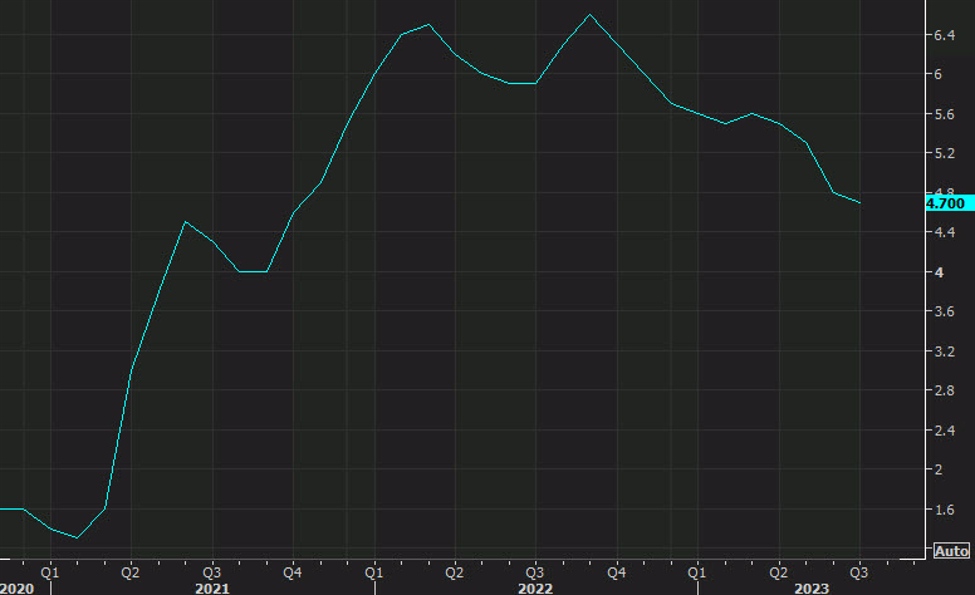It’s been a sluggish start to the US trading week (though not the Tokyo week) but that will change on Wednesday with the release of the August consumer price index report.
There’s no scope for this data point to meaningfully change the odds of a September Fed rate hike, which is currently priced at just 7%. But it will move the November/December pricing, which is closing in on 50%.
There’s an ongoing debate in the market about which is more important, the headline number or the core. Let’s start with what’s expected:
- Headline +0.6% m/m and +3.6% y/y
- Core +0.2% m/m and +4.3% y/y
The headline number is expected to accelerate from July while core is expected to moderate.
Core y/y
In general, the market will lean towards core as the better indication of the underlying trend but the reaction might not be straightforward. The market will parse through details like housing and used car prices to try and get a sense of deep underlying pressures. Shelter has kept inflation higher than it would be but owners-equivalent rent lags badly and that’s why markets are pricing in a return to low inflation.
The headline is all about energy and the reinvigoration of oil and gasoline prices. That factor was further underscored by a fresh 10-month high of $88.90 in WTI crude on Tuesday. The boost in oil prices is a major headache for markets and one of the reasons that the market is now 50/50 on an ECB rate hike Thursday.
As I think out to next year when the market is pricing in Fed cuts starting in June, I also think about the potential oil has for delaying that. If crude prices stay at these levels, headline inflation will remain well above target and make it tough for the Fed to cut. Moreover, OPEC+ is materially tightening the balances in the oil market and there’s a chance oil rises to $100 or beyond.
That’s why I think the risks are skewed towards a higher CPI reading. Said differently, a low number would lead to a small positive reaction while a high number could lead to a larger negative reaction from risk assets. Similarly, the US dollar stands to benefit more from an upside surprise than a downside one.
The US economy simply isn’t slowing down as quickly as many thought and today Walmart and Bank of America both highlighted the resilience of consumers. That’s going to put pressure on the Fed to hike further.
Moreover, looking at the big names in forecasting, there’s an upward bias to the consensus numbers:
Here’s what Goldman Sachs has to say as a preview for Wednesday’s US August CPI report:
We highlight three key component-level trends GIR expects to see in this month’s report: 1. A 3.1% decline in used car prices and a 0.2% decline in new car prices in August, reflecting lower used-car auction prices and continued increases in auto dealer promotional incentives. 2. Residual seasonality and higher airfares (+6%) to result in a 4.3% increase in public transportation prices this month. 3. Shelter inflation to remain roughly at its current pace (we forecast rent to increase by 0.40% and OER to increase by 0.48%), as the gap between rents for new and continuing leases continues to close. Going forward, we expect monthly core CPI inflation to remain in the 0.2-0.3% range in the next few months. We expect continued moderation in shelter inflation and lower used car prices to be offset by a swing in the CPI’s health insurance component when the BLS incorporates new data and a methodological change in October. We forecast year-over-year core CPI inflation of 3.8% in December 2023 and 3.0% in December 2024
So on net, the market will go with whatever the kneejerk shows on the headline, with a bias towards core. But longer out, the chance of persistently high inflation and a longer wait towards Fed cuts is building. That leaves me with a bias towards USD strength after the release.
